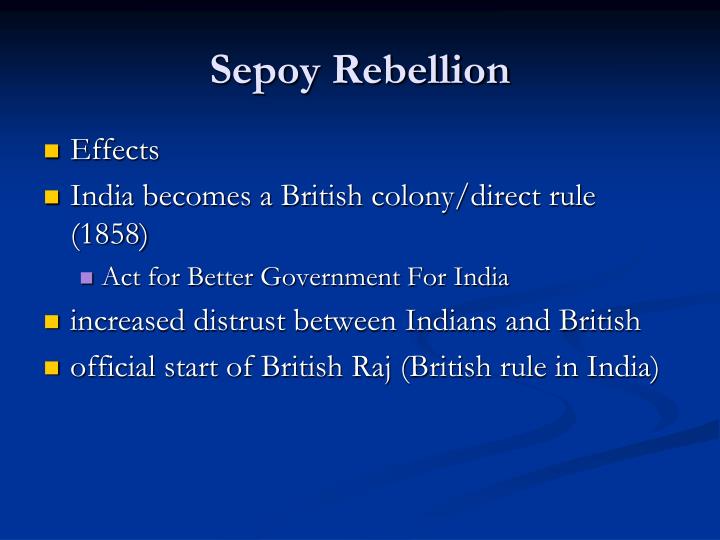

The table of contents lists thirty-four documents, though in fact several of these are different sections of the same work: for example, Documents 1, 5, and 19 are all selections from the 1873 translation of Syed Ahmad Khan’s Causes of the Indian Revolt (1858).
Sepoy mutiny causes and effects series#
James Frey’s book, like others in the series, consists of a moderate-length narrative, slightly over half of the book’s total length, and a series of primary-source documents selected and edited by the author. So perhaps it should come as little surprise that Hackett Publishing Company, having published in 2017 Ian Barrow’s volume on the history of the East India Company, should follow it with a volume on this key moment in India’s modern history. It has also taken a place of privilege in many histories of modern India, as the moment when Parliament replaced early colonial rule under the British East India Company with “Crown” rule, overseen directly by the British metropolitan government. The rebellion in northern and central India, beginning in 1857, has been the object of countless published works, several of them published even before July 8, 1859, when the Government of India officially declared India to be at peace.
Sepoy mutiny causes and effects pdf#
Re-envisioning Asia: Contestations and Struggles in the Visual Artsĭownload PDF By James Frey Indianapolis: Hackett Publishing Company, 2020 224 pages, ISBN: 978-1624669033, Paperback Reviewed by Brian P.Distinguished Service to the Association for Asian Studies Award.Distinguished Contributions to Asian Studies Award.Striving for Diversity, Equity, and Inclusion in Asian Studies: Humanities Grants for Asian Studies Scholars.Gosling-Lim Postdoctoral Fellowship in Southeast Asian Studies.Cultivating the Humanities & Social Sciences Initiative Grants.AAS Takes Action to Build Diversity & Equity in Asian Studies.AAS Community Forum Log In and Participate.

Note - The main causes of the failure of the Revolt of 1857 firstly the lack of unity, planning and efficient leadership on the Indian side and secondly the organisational and military superiority of the English side who was led by very able and experienced generals.

As a result of all these factors, the revolt of 1857 was easily suppressed. The Presidencies of Bengal, Bombay and Madras did not take part in the revolt and neither did the Sikh soldiers. The rebellion was limited to North India. Thirdly, not all sections of Indian society participated in the revolt. They had not placed much thought on how they would run the government after the Britishers were ousted. Secondly, Indian leaders did not have a common foresight or plan as to what they would do after the revolt ended. In general, the organisational and military superiority of the British forces made it very easy for them to suppress the revolt. The Indian side was poorly trained and not well armed, whereas the highly disciplined British troops were armed to the teeth with weapons. As opposed to this, the British troops were well organised and managed by talented leaders such as Havelock, Outram and Campbell. There were local leaders but the revolt lacked a National level leader who could unite all the forces and use them effectively to the enemy's detriment. Even though there were a lot of localised rebellions spread over a wide area these were not coordinated or organised. Firstly, the revolt lacked planning and unity. However, after some initial setbacks, the Britishers brutally suppressed the revolt and swiftly regained all lost territories. The revolt saw the soldiers, peasants and even many local rulers, princes and dispossessed Zamindars fight against what they called the firangi rule. The revolt started in Meerut, and from there spread like a fire engulfing almost all of North India. However, the immediate factor which led to the outburst of the rebellion was the rumour about the cartilage of the Enfield Rifle being made out of cow and pig fat. There were several religious, social, political and economic causes which had set into motion an atmosphere of general hatred towards the foreign government. The Revolt was however swiftly suppressed by the English authorities.Ĭomplete Step by Step Answer - The factors which led to the onset of revolt is multifaceted. For the first time in the history of colonial rule, there was a PAN India struggle to oust the foreign government. Hint - The Revolt of 1857 is often referred to as the First Was of Indian Independence.


 0 kommentar(er)
0 kommentar(er)
